Dear Barbara,
Of all the places I ever dreamed of visiting, Syracuse is the one with the most poetic name. It’s something about the syllables that echoes like a forgotten melody in my ears. I have read so many things about Syracuse and Sicily in school, but now that I finally visit this legendary city, I can’t remember anything. It’s probably better this way.
It is a short journey from Catania to Syracuse by train. After one hour across fields, the landscape becomes more industrial. Silos and pipes cover the horizon shortly before entering the city. I have no idea what to expect, but my anticipation is high. I can’t recall when was the last time (if ever) that I dreamed of a place the night before visiting it. It actually happened last night, it was just a quick scene, but it seems that I was there for some moments.
Now, I’m about to leave the train station behind. I can’t see anything right now: there is strong sunlight straight to my face and some distant smell of fish. I am, once again, in the Mediterranean.
The ear of Dionysius in Syracuse
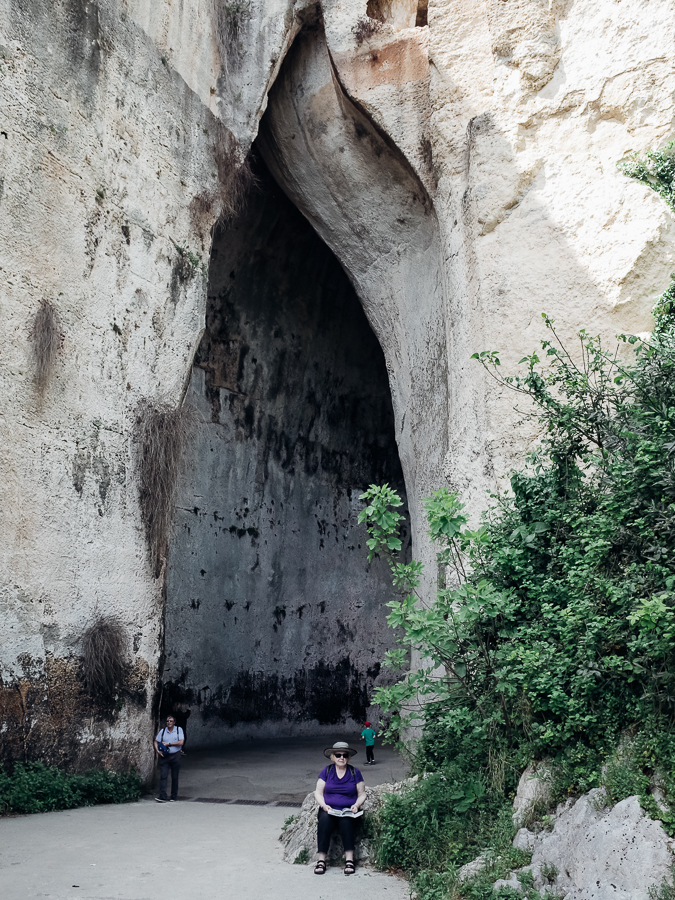
Although I’m tempted to go straight to the waterfront, I decide instead to visit the archeological park of Neapolis. It is located in the northern part of the city, and it is -as the name suggests- one of the most important sites in Syracuse. All the city’s past seems to be compressed in this wide land plot beyond the narrow highway.
Apart from poetry, there is torture in Syracuse, too. Although I walk all along the archeological park of Neapolis, I’m mainly interested in seeing the Ear of Dionysius (Italian: Orecchio di Dionisio). This odd name refers to a limestone cave in the park, which is very tall and resembles a human ear. The name was Michelangelo da Caravaggio’s idea, and the truth is that it really looks like one. If you walk inside the cave, the acoustic is really amazing: people say that it multiplies 20 times the human voice. Some echo that is.
But who was Dionysius? Well, it is a direct reference to the tyrant Dionysius I of Syracuse. It’s said that Dionysius used the cave as a prison for his political opponents -and a tyrant usually has quite a few of them. Due to the impressive acoustics of the cave, Dionysius could listen to the plans of the inmates. The legend goes a step further, suggesting that Dionysius also enjoyed hearing the inmates screaming when they were tortured.
Some historians claim that this is just a made-up legend by Caravaggio himself. Anyway, no matter where the truth really lies, the Ear of Dionysius is an impressive cave. It is 23 meters high, and it’s visible from quite some distance.
Latomia del Paradiso
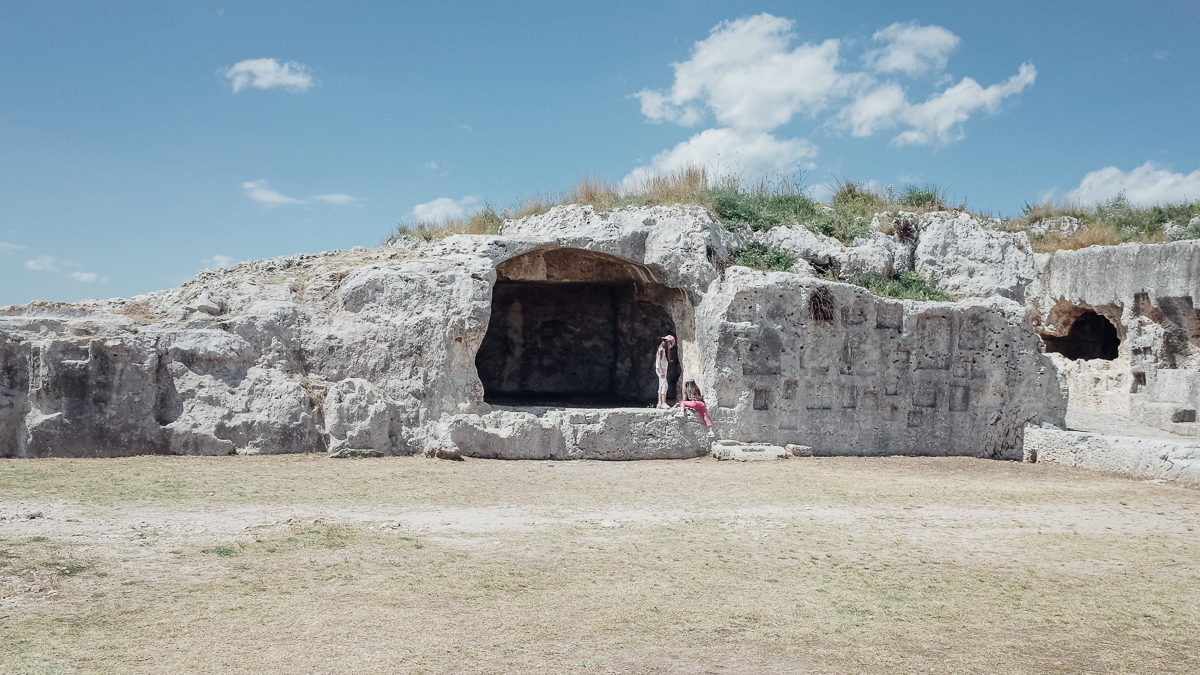
The Ear of Dionysius is part of an area called Latomia del Paradiso. Once again, Syracuse is poetic in terminology. The Latomia del Paradiso refers to deep quarries for the extraction of stone; nowadays, though, the quarries of paradise are full of flowers, totally transformed into gardens. As for the term Paradiso, it refers to some belt covering the city from west to east.
I walk for quite some time around the Latomia del Paradiso, and now and then, I enter the Ear of Dionysius. It is a warm afternoon, and people scream here and there, pretending to be inmates. At some point, a guy starts singing, and everybody remains ecstatic. The echo creates a wonderful atmosphere; however, one should never forget that not every voice used to sing inside there.
The Greek Theater of Syracuse
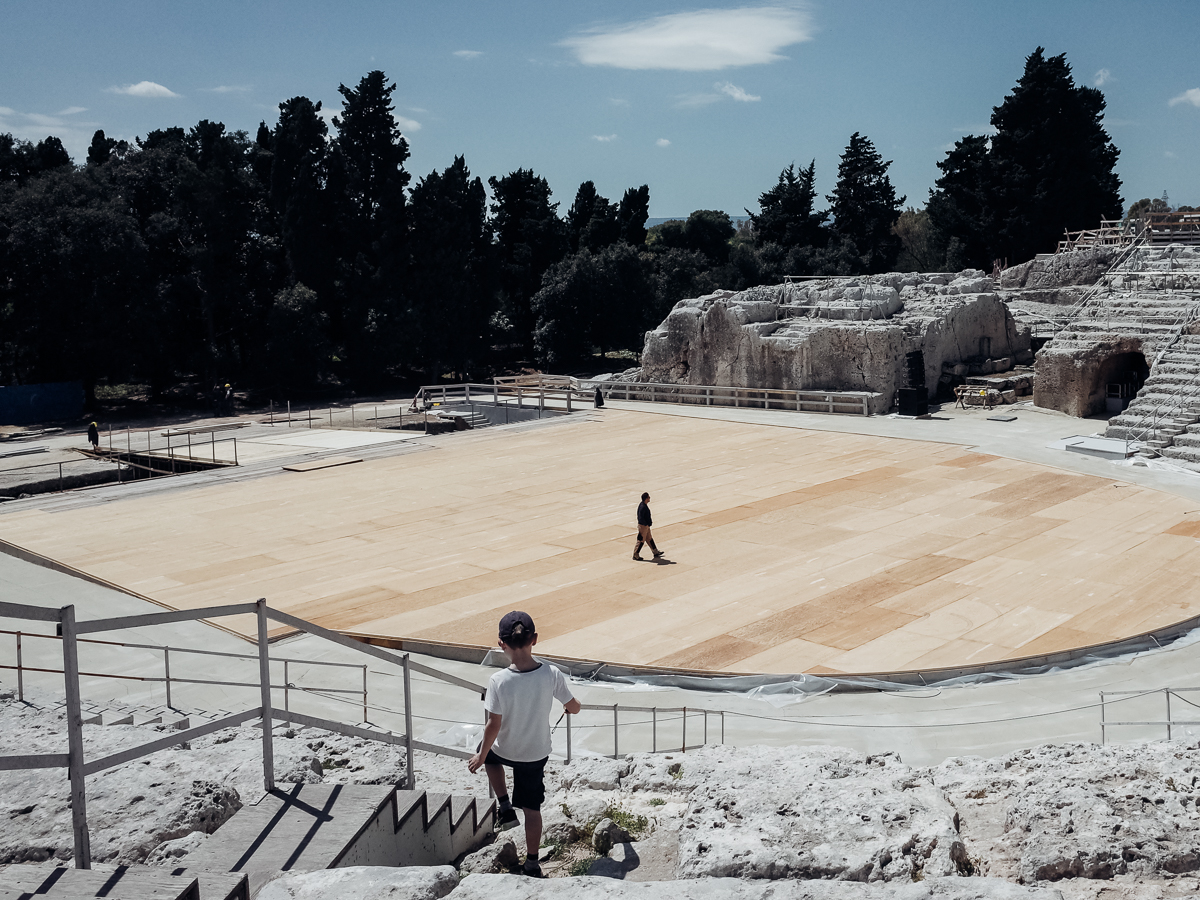
Before leaving the Neapolis, I spend some time at the Greek Theater of Syracuse. For most of the visitors, that’s the highlight of the archeological park of Neapolis.
The day I visit it, there is some construction going on; therefore, I don’t have the chance to see it as it really was. However, this is an impressive theater dating back to the 5th century BC. In this theater, Aeschylus staged “The Women of Aetna”: this tragedy, which didn’t survive through the centuries and it’s considered lost, was written to celebrate Catania’s re-foundation. Aeschylus most likely wrote the play during one of his visits to Syracuse, around 476/5 BC.
Like most of the Greek theaters of antiquity, the Greek Theater of Syracuse also celebrates panoramic views. The theater overlooks the bay of Syracuse and the island of Ortygia.
Take that postcard

As I walk down the road, a man from a small shop hands me a postcard. “Take that postcard,” he says, and then he pays no attention to me at all. I stop, slightly confused, and I look at it. It is an old photo of the Temple of Apollo in Syracuse. The temple became a church in Byzantine times and a mosque under Arabs.
One can talk forever about the buildings of Syracuse. But I’m not here only for the legendary monuments of the past. I’m in this ancient Corinthian colony to listen to the city’s stories, to see Ortigia, and since last night I dreamed of Syracuse to see if I can find the place of my dream. I’m here for the poetry but not for the torture.
After a short walk, I approach one of the bridges leading to Ortigia. This is the most famous place in Syracuse and one of the most known around Sicily. I cross the Ponte Umbertino bridge, and I walk towards the temple of Apollo. I have the postcard in my hand, and I try to see if there are any differences. Apart from the colors that seem less vibrant, everything else is intact.
On the corner of the square, there is a teenager drawing something in a sketchbook. I always envy people that know how to draw; it’s something that I can’t do. I have two left hands when it comes to drawing. She looks very dedicated. I approach her, and I say: “Here, take that postcard.”
I don’t look back, but I guess she is as surprised as I was when I got it.
Ortigia is a place to spend your life
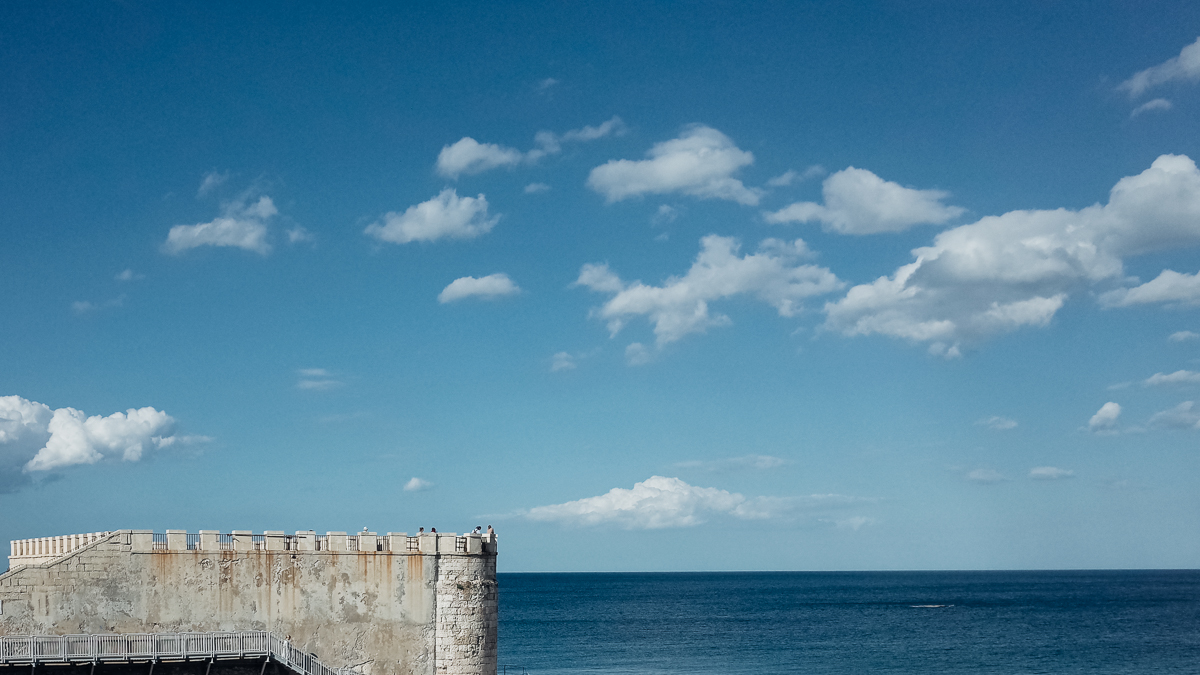
It’s impossible not to like Ortigia.
The strange name means quail in English, and it originates from ancient Greek (ortyx). As I walk down the narrow streets, I think of the life of the 4,000 permanent inhabitants residing on that little island. Waking up next to the sea, seeing colors everywhere, and living in a city full of poetry and torture. It’s probably not like this, I know, but the truth is that I miss the Mediterranean lately.
The sea is present here in every step you take. In Catania, for example, the sea seems absent sometimes -and in Taormina, it’s more the century-long decoration that makes the scenery dramatic. But in Ortigia, the mythological home of Arethusa, the sea is everywhere. I walk around the beltway road that seems to have a dozen of names: Lungomare d’ Ortigia, Via Eolo, Via Nizza, Via dei Tolomei, Lungomare di Levante Elio Vittorini. The street that circles the small island is, in fact, a never-ending veranda to the open sea.
The walls are high, and the sea is down below. Once in a while, there is an opening in the wall, and a metal staircase goes all the way down. The beaches of Ortigia, scattered here and there, are already hosting people. Most of them are youngsters; they are loud and have slender bodies. They stretch under the sun, and some of them, probably the ones that need some extra attention, swim. The sea is still cold, but as I see that boy and that girl swimming, I can only wish for a long, lazy summer.
Then, I accidentally find myself inside the narrow streets again. I end up in front of the Duomo of Syracuse. It’s an impressive church, but having seen the sea and the people swimming, I don’t care about one more impressive church. It probably means a lot for the locals, but for the visitor that has reached the Mediterranean after a long winter, the only God is the one on the other side of Ortigia, where a boy and a girl are swimming. It’s only the open sea that matters.
Of pigeons and men
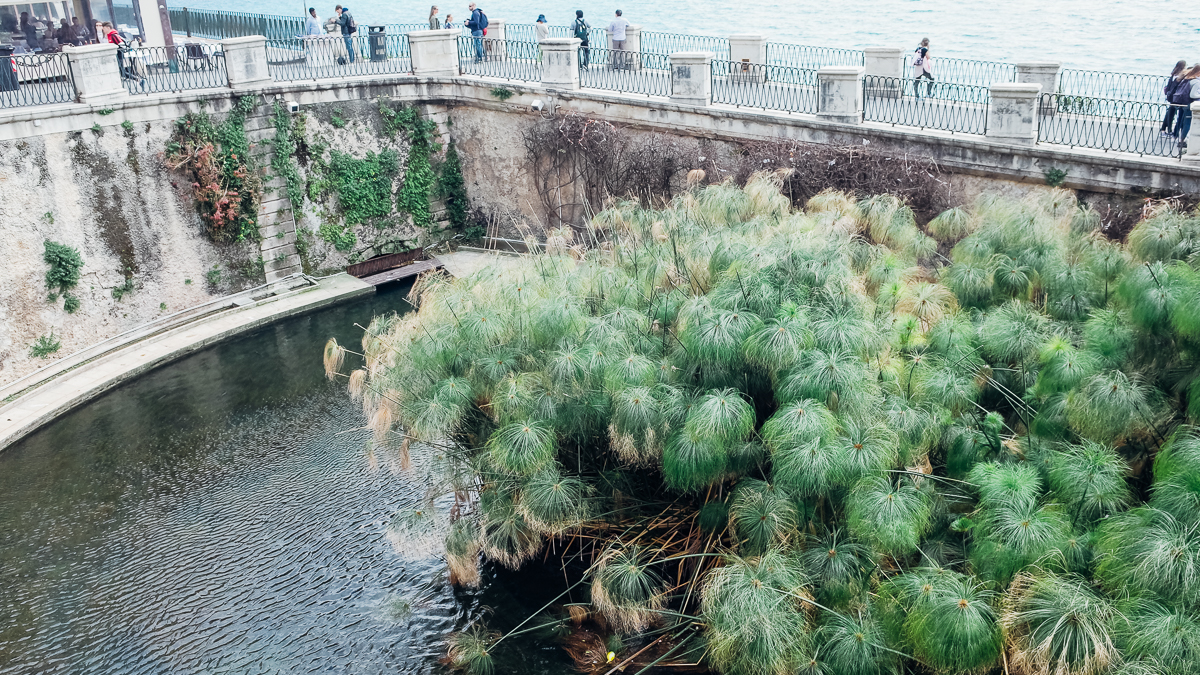
I cannot leave Ortigia just yet. I prefer to sacrifice a part of the sightseeing to stay longer in this place.
It’s impossible to get lost on that tiny island. All the roads lead either to the water or to the two bridges. I don’t need a map here, and I just walk toward whatever gets my attention. Soon, I find myself on the other side of Ortigia, close to Lungomare Alfeo. This is actually where the Fountain of Arethusa is located. According to mythology, this is where the nymph Arethusa (and patron figure of ancient Syracuse) returned to the earth’s surface. She escaped from her undersea home in Arcadia. Apart from that, the Fountain of Arethusa is one of the two places in Europe where papyrus grows (the other one is in the province of Catania).
It’s not a big surprise that there is a number of cafes next to the Fountain of Arethusa. They have an old-fashioned style, reminding me a lot of the late ’80s in Greece. They seem touristy, and even though I’d love to have an espresso, I decide to walk. It proves to be a good choice because, after a garland of tourist cafes, I see Mikatú. This small cafe stands almost on the edge of Lungomare Alfeo and has a terrace directly to the sea.
The sun is intense, and I will probably get tanned if I stay there. It’s an easy choice: I sit there, and I order an espresso and “the biggest bottle of sparkling water” -well, it’s just one liter. The sun comes straight to my face, but a generous wind refreshes everything in the Lungomare. But soon, the wind becomes stronger, and that’s when the first napkins start to fly. Soon, the receipts will follow, and when the wind becomes strong enough, the potato chips start to fly here and there.
The flying chips attract pigeons. They fly from every place in Ortigia, and they come here to the little bar Mikatú to chew. The waiter chases them -well, let’s say he encourages them to leave. A client next to me says that it’s okay. The waiter laughs. “Ah, you know,” says with a thick Italian accent, “it’s just our way to train pigeons in Syracuse.”
What to do when dreams don’t come true
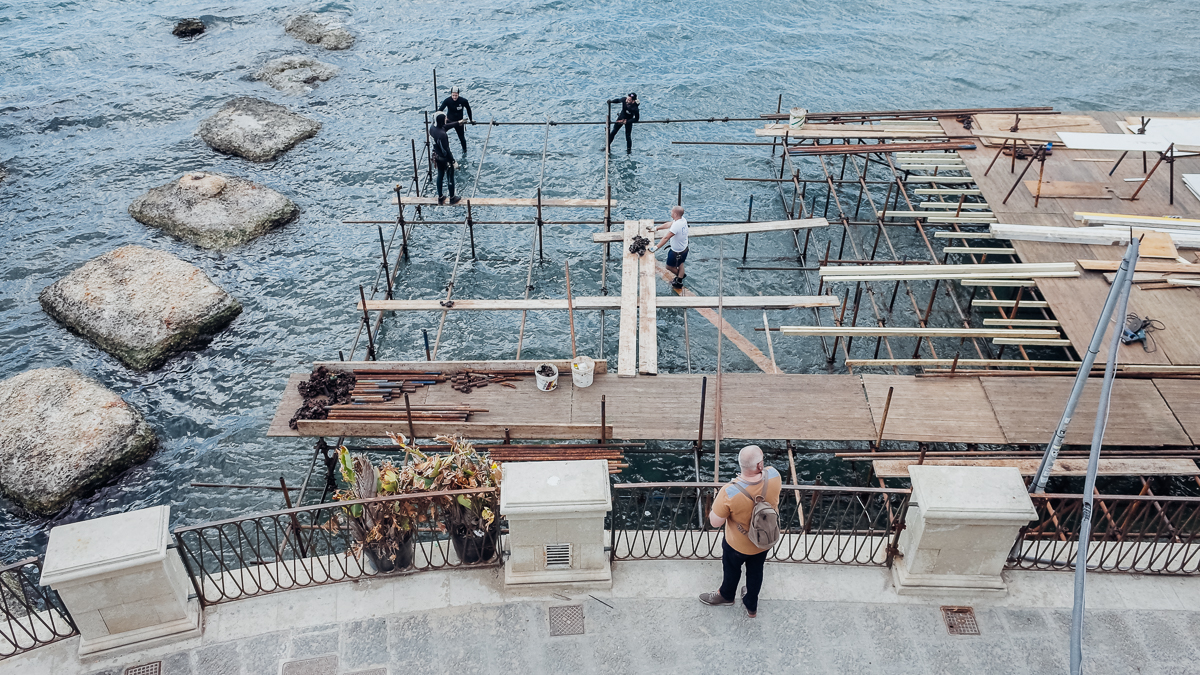
I keep postponing my departure from Syracuse until I face the obvious problem: I don’t have a place to stay here.
It’s only then that I realize that I won’t stay in Syracuse forever. During the walks around Ortigia, I felt that I could somehow stay here for ages. Well, it’s now 7 o’clock, and if I don’t rush, I will lose the last train to Catania. I would normally be in a terrible mood, but somehow, I’m in a state of full bliss on my way to the train station of Syracuse. It’s probably because visiting Syracuse exceeded my expectations.
And then, as I walk quickly to get the train at 7:30 pm, I remember last night’s dream. I didn’t see in Syracuse the spot I dreamt of. On the other hand, I saw so many places to dream of in the future. Well, when the dreams don’t come true, there is only one thing to do: you should promise to retry again and again. In this case, though, it means that I will have to return to Syracuse soon.
It has been a long day here in southeastern Sicily. I manage to get to the train station 5 minutes before departure. I see the train station of Syracuse washed in the most orange light I’ve ever seen. A few minutes later, the train starts its short journey back to Catania. A girl is drawing on the other side of the wagon. I can’t tell if she’s the one that I gave the postcard to. For no apparent reason, I sink into my seat shyly.
And I daydream of Syracuse for the rest of the journey.
Love,
George
More about Syracuse: The best tours in Syracuse, Italy
More about Sicily: Taormina guide, A travelogue about Catania, A tour to Etna & Things to do in Catania
*Get my FREE Travel Writing Course*
Buy the camera I use | Book your hotel in Syracuse
Pin it for later
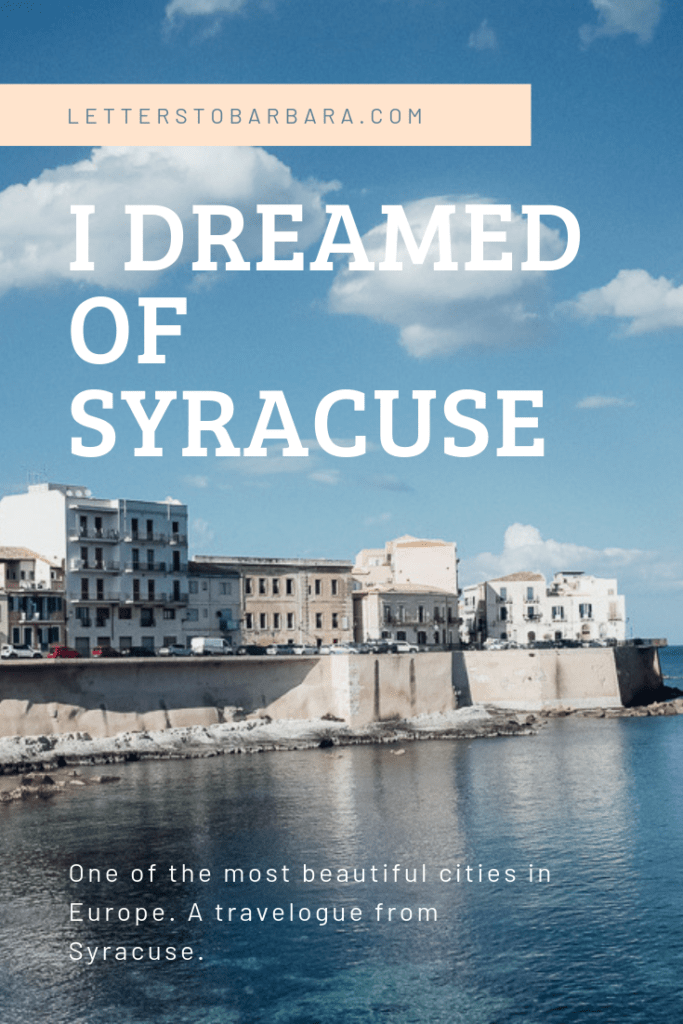
Please share, tweet, and pin if you enjoyed reading I Dreamed of Syracuse. Your support keeps this website running and all the info up-to-date. 🙂
Last Updated on July 29, 2023 by George Pavlopoulos

Dear George, wonderful images and fantastic colors; I love the the clarity and the deep blues. Sicily must be beautiful, I have never been there – but this must be changed next. Thank you a lot for sharing these wonderful images and the inspiring text with us!
Dear Christian,
So glad to you here! Indeed, Sicily is a wonderful place and Syracuse is a photographer’s dream! I totally encourage you to visit Sicily, you will love it there. Thanks for your kind comment 🙂